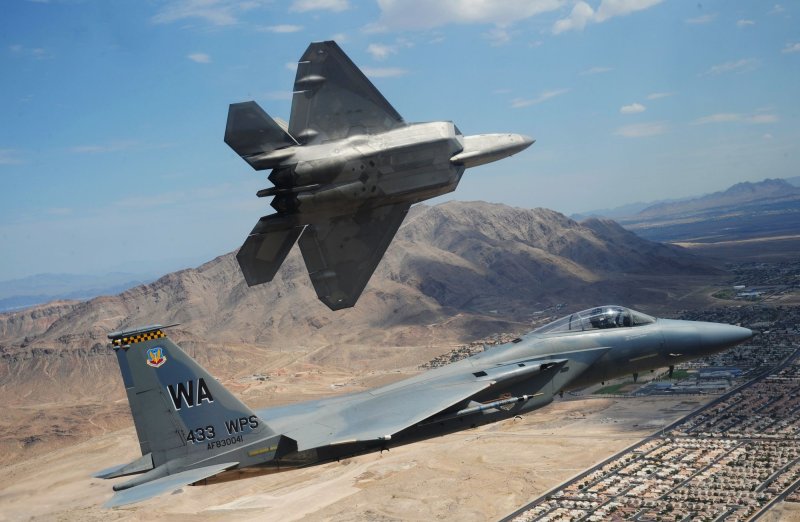1 of 2 | An F-22 Raptor aircraft peels away to land while an F-15 Eagle aircraft flies the approach at Nellis Air Force Base, Nevada on July 16, 2010. It could take a decade for the Americans to deliver the package of Boeing F-15 Eagle fighters, Boeing AH-64D Apache Longbow helicopter gunships and precision-guided munitions to the Saudis. UPI/Kevin J. Gruenwald/U.S. Air Force |
License Photo
RIYADH, Saudi Arabia, Oct. 26 (UPI) -- U.S. plans to sell Saudi Arabia advanced weapons systems worth $60 billion to counter Iran could turn out to be more of a problem than a panacea.
The Saudis, unlike the Israelis, have always had problems absorbing high-tech Western systems since they began buying state-of-the-art war machines in the 1970s.
Right now, they already have more top-line equipment than they can effectively use, such as an air force with more aircraft than it has front-line pilots or commanders able to deploy them in combat.
Saudi Arabia traditionally bankrolls part of Pakistan's military purchases and in return gets experienced Pakistan pilots to fly its U.S. and British combat jets, as well as seasoned naval personnel to run its two-sea navy.
"Militarily … Riyadh's challenge is not a matter of hardware: Saudi Arabia already fields a broad spectrum of some of the highest-end and most modern military equipment in the region," the U.S. global security consultancy Stratfor commented.
"Instead, its challenge is fielding that hardware. With deliveries years away, the new deal will do little to balance the resurgent Iranian regime in the near-term, and prolongs Saudi Arabia's heavy dependence on U.S. defense support."
It could take a decade for the Americans to deliver the package of Boeing F-15 Eagle fighters, Boeing AH-64D Apache Longbow helicopter gunships and precision-guided munitions to the Saudis.
So it's unlikely the Iranians are quaking in their boots at the prospect of their main rival in the Persian Gulf region being deluged with top-line weaponry.
And, in the end, it is doubtful that it will make Saudi firepower any more potent than it is already unless the Saudis upgrade its military leadership and doctrine and develop professional cadres able to use high-tech weapons competently.
"The immaturity of the Saudi training and doctrine and underlying issues with manpower are pervasive," Stratfor declared. "Such issues can take a generation to even begin to resolve …
"If the new hardware is accompanied with serious reform, then … the Saudis military might become a significant force. Until then, for all its military hardware, Saudi Arabia will remain relatively weak in terms of defense."
Most of its $34 billion defense and security budget is spent on maintaining and upgrading large stocks of air, land and naval equipment purchased since the 1970s.
Most of this work is carried out by an army of expatriate specialists from Western defense manufacturers because the Saudis can't do it themselves. So the influx of more advanced equipment is likely to strain Saudi resources even further.
King Abdallah has over the last year or so taken charge of all defense purchases in an apparent effort to reduce the power of the Defense Ministry as the health of the long-serving minister, his half-brother Crown Prince Sultan, has deteriorated.
The monarch personally conducted much of the negotiations for the U.S. arms package.
For one thing, he has long sought to stamp out rampant corruption in the arms procurement system, in which colossal kickbacks are made to Saudi officials.
But Abdallah may have other considerations in mind. He commands the National Guard, or SANG, a 100,000-strong force drawn from tribes loyal to the monarchy. It's the king's private army, totally separate from the 140,000-strong regular forces controlled by the Defense Ministry.
SANG traditionally has been a light mechanized force. But Abdallah wants to give it more firepower with armor and artillery and has ordered his eldest son Mutaib, the SANG commander, to carry out a major $3 billion reorganization.
The AH-60 Apache gunships and other systems in the U.S. package are clearly earmarked for this force, whose traditional mission has been to protect the royal family. It is also expected to be redeployed to protect strategic oil installations as well.
"Like many Gulf Arab states, the Saudi regime has long feared its own military more than any external threat," Stratfor observed. "The Saudis have relied on the United States to deter and defend against external threats.
"While military interests receive generous allotments of money and modern defense hardware, they have lacked the organization and leadership to employ that equipment effectively.
"In many cases, they have been kept deliberately weak doctrinally and institutionally to prevent them from becoming capable of mounting a coup."















